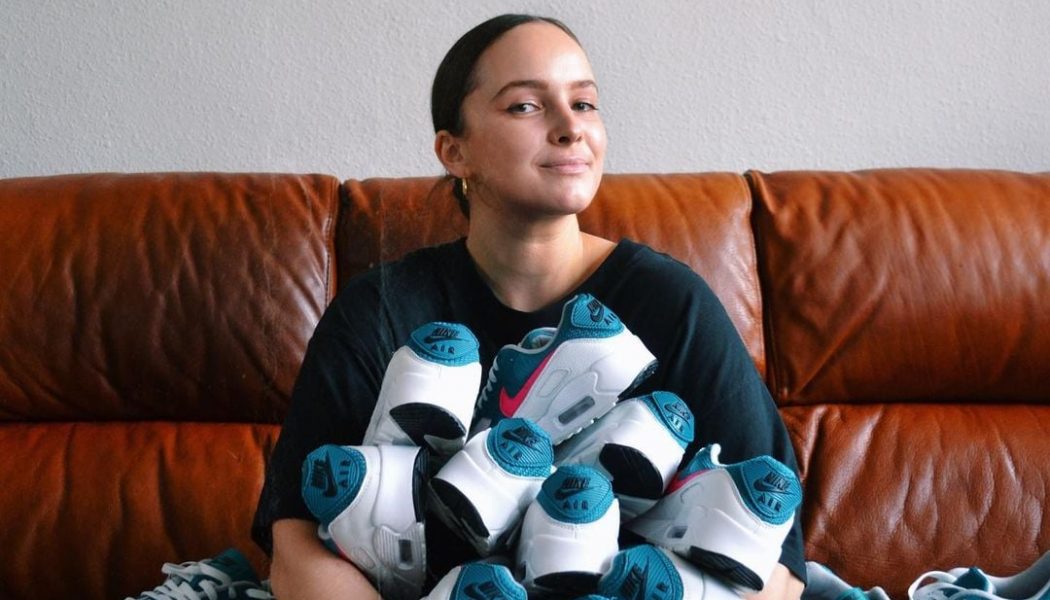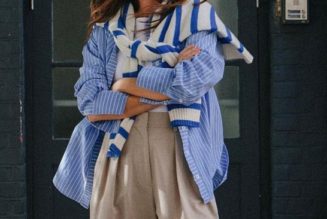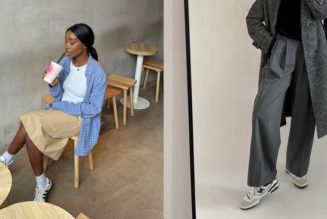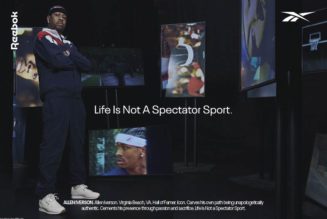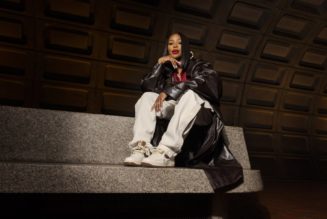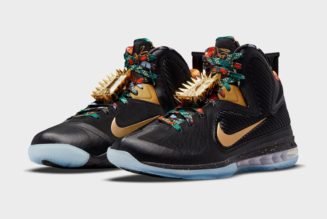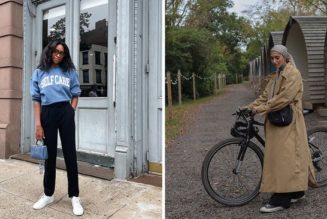
Image Source: Titi Finlay
I’ve always felt intimidated by the sneaker industry, despite having worked for two major sneaker brands in my life. As a humble shoe size four, there are immediately limits to what sneakers I can and can’t wear, and I’m not alone in that exclusion. The industry has predominantly favoured the needs of men over women, and it’s a problem that has existed for a long time. “The reasons for the sneaker industry not being inclusive stems right back to women’s sporting history,” Angelee Kholia, the founder of Sheaker Magazine, told POPSUGAR. “Sneakers were primarily made for sport, and of course, it was frowned upon for women to participate in sports, unlike for men. So the sneaker industry has always favoured men’s needs over women’s, and unfortunately this hasn’t changed with the times.”
Despite having come a long way in recent years, the sneaker industry is still missing the mark when it comes to gender inclusivity. Whether it’s women missing out on exclusive collaborations because our size isn’t stocked, being overlooked for opportunities in favour of male counterparts, or falling prey to the narrative that “women can’t be sneakerheads”, there are a number of ways that the lack of inclusivity in the industry is evidenced. I spoke to collectors, founders, and members of the communities at the forefront of the industry to get their views on why this might be and how it can be changed.
An Industry Geared Toward Men
“The sneaker industry is built on this gender disparity,” Kholia said, explaining that “it has always been geared more toward men, from separate drops to more media coverage on men’s content. While there is a big call for change, there is still a long way to go in order for brands to become more inclusive.”
And it’s not just women in the industry who feel this way; some of their male counterparts feel it, too. Ronal Raicha is the founder of Crepe City, one of the most well-known sneaker communities in the UK. For him, the industry has continued to grow in this way partly because of the people inside it. “Historically, the industry has always been male dominated. There’s guys who were able to get into the industry in the ’90s who have then brought in their pals, sometimes because they’re biased, and sometimes just because they want to bring in people they trust. Some brands are very much geared up to pub culture, though, only working with people who want to go out and drink pints all night,” he told POPSUGAR.
Titi Finlay is a creative for Nike and has been collecting sneakers for years. She feels there are two main aspects where the industry lacks in terms of inclusivity: sizing and storytelling. “To give some context on sizing, the majority of the time, the hype sneakers only release in a UK6 and upwards, so people with smaller feet (mostly women) miss out on so many great releases. There is sometimes a grade-school (GS) version released alongside the adults’ drop, but these usually have cheaper materials or altered design features. It’s really frustrating not to be recognised in that sense, and I’d love to see brands work on releasing sneakers in a full size run for all the drops,” she said.
At the core of it, women consumers just want to be taken seriously. Jess Lawrence, an influencer within the community, boiled it down to the fact that “as loyal consumers, women want to be heard by the brands and companies we buy from. We’ve been asking for size-inclusive runs, so that those of us with smaller size feet aren’t left out of releases. We don’t necessarily want women’s exclusives, but just to be included in the messaging and marketing for all the releases that do exist. Often, women’s releases come with patronising gender signifiers, such as classically feminine colours or having a platform, when really, we just want pure inclusion.”
Leaving the Judgement Behind
For progress to be made, the way female sneakerheads are perceived online needs to change. Associate Editor at Hypebeast Tayler Willson believes that the language used on social media is a big contributing factor. “Whether it’s the way something is styled or simply how a caption is written, more often it’s strikingly obvious that it’s targeted at males,” he noted. To really change this, the sneaker accounts who have a large following would need to set an example by catering to sneakerheads of all genders. Otherwise, the judgement on social media against women in the community will continue to exist. Willson would like to see more women at the design level, too. “I know it’s improved in recent years, but it needs to improve faster. Things like collaborations, designs, and campaigns led by females from start to finish need to happen more often, and they need to be given the same platform as men.”
“We don’t necessarily want women’s exclusives, but just to be included in the messaging and marketing for all the releases that do exist.”
Dedication is also called into question for female sneakerheads, especially when women are seen to “start” collecting trainers at a later date. Tegan Price, head of creative at The Sole Womens, said that “there’s a lot of judgement within the sneaker community toward girls, or people who start collecting sneakers at a certain time. This is especially if it was ‘too recently’, or if their collection isn’t ‘high heat enough’. I see this most when girls from the scene are reposted onto large sneakers or fashion-based accounts, people who claim to have been collecting since they could remember get salty, and things start getting personal. It’s something that definitely needs to be left out of it.” Price also added that influencer culture online has its part to play, too, noting that “social media has really put the pressure on a lot of people to have the best kicks to fight off any kind of impostor syndrome.”
As a woman, the reason behind your involvement in the scene is often interrogated, which can be off-putting in itself. Finlay explained that “there is still this misconception that women are only into sneakers ‘for the likes’ or that we have only just discovered sneakers recently because of Instagram.” For her, feeling excluded from the industry dates back to 2015, when groups like The Basement (another male-focused sneaker community) were in their prime. “There wasn’t much representation for women in sneakers back then, so I used to shy away from posting about my love for them just in case I got called out or made fun of for not knowing enough. It’s funny to look back now, because in the past few years, this has completely changed, and women are really at the forefront of the culture,” she said.
Transitioning Into a More Inclusive Space
For the most part, it is up to brands to start leading the charge in terms of changing the industry for the better, and it starts with the hiring process. Kholia believes that “the responsibility does lie on brands to change the way they make, market, and sell sneakers and for them to truly understand what women need and want from their footwear. This will only happen when women are hired in these big decision-making roles,” she explained. Stephanie Hulbert-Thomas, founder of Women in Sneakers, agrees, and she reiterated that “having women in decision-making roles and innovation roles within brands and media would be truly beneficial to the overall sneaker and streetwear scene.” Raicha also emphasised the fact that the hiring process is key, explaining that “brands need to question themselves more when they recruit and recruit from different social classes and ethnicities. They also need to make sure they aren’t just considering diversity in order to tick a box, but to really be genuine.”
“Women are powerful and ready; we just need to be given the space to flourish and stand our ground.”
Luckily, brands are taking notice and beginning to understand the importance of providing seats for women at the table. “The impact and power of women in the industry cannot be denied,” said Jasmine Bellamy, head of merchandising at Reebok. “If brands want to be successful, they will move from theory to practice by taking action to ensure women are included in the highest ranks of leadership.” The next step, after hiring diversely, begins with addressing the issues within size runs, which also falls on the brands. Finlay said that “I would love brands to really prioritise releasing sneakers in full size runs (even if it means limited numbers, it would still be great to know we have a chance rather than instantly missing out because of our shoe size). As well as that, I’d love brands and retailers to continue telling the stories of ALL types of female sneakerhead, not just the ones who get the likes on Instagram.”
While it is brands that have the power to really make progress, change can also start from within the community. Kholia observed that “talking to male sneakerheads about the disparities for women can open up important conversations and bring so much more awareness to the gaps in the industry,” while Hulbert-Thomas believes that “the only way we will see change is through continuing to have conversations about our experiences and ultimately not be afraid to speak up and demand change.”
For influencers like Lawrence, having the support of the community is one of the most important tools for success in this space. “From the ground up, we need people calling out sexist behaviour, whether it’s on social media, in campaigns, or in conversations; everyone can help by schooling their friends and acquaintances and making sure the narrative changes completely — womxn are just as into sneakers and are just as important in the industry,” she said. Kelly Tennant from The Sole Women’s agrees, adding that “there could definitely be improvements in the community in terms of how people interact with one another online, just generally being kinder, more open-minded, and more adaptable to change. Allowing new people to join the community with open arms is so important to ensure that the industry thrives, especially now, with such uncertain times ahead.”
From a brand perspective, it’s clear that female consumers and their concerns are beginning to be taken seriously and that even more progress is possible. “The overall female positioning is changing, and so is the dynamic of the market,” said Emma Virgile, the senior product line manager for Puma Sportstyle. “Before, the power and knowledge of the female sneaker consumer was underestimated; now, you can see their relevance in the industry by the increase of female products offers, store spaces dedicated to female ranges, and stores dedicated exclusively to the female consumer. There’s always space for improvement, and we, as a brand, every season, work together to do better.”
Moving Forward
The lack of gender inclusivity in the sneaker industry comes as a result of years of sporting history, male-owned communities, and not enough of a demand from female sneakerheads. That’s different now, so the industry needs to be different, too. “The female consumer has been vocal about their needs, media and influencers have been sharing these messages to the wider audience, and brands have been adapting to provide their female consumers with a good sneaker range that meets their expectations,” Virgile from Puma said. It’s clear that progress is being made, but more work still needs to be done.
“Highlighting the amazing women in the space is crucial,” Lawrence said, and collectively, it’s the likes of communities like Women in Sneakers and Sheaker Mag and role models like Melody Ehsani, Olivia Kim, Vashtie Kola, and Yoon Ambush who are leading the charge for a more inclusive space. We can only hope that as female communities and representation grows, the mindset of the once male-dominated sneaker industry does, too. As Lawrence put it, “Nobody wants to be patronised; we don’t need elevation; women are powerful and ready — we just need to be given the space to flourish and stand our ground.”

Image Source: Lauren Fernandes
